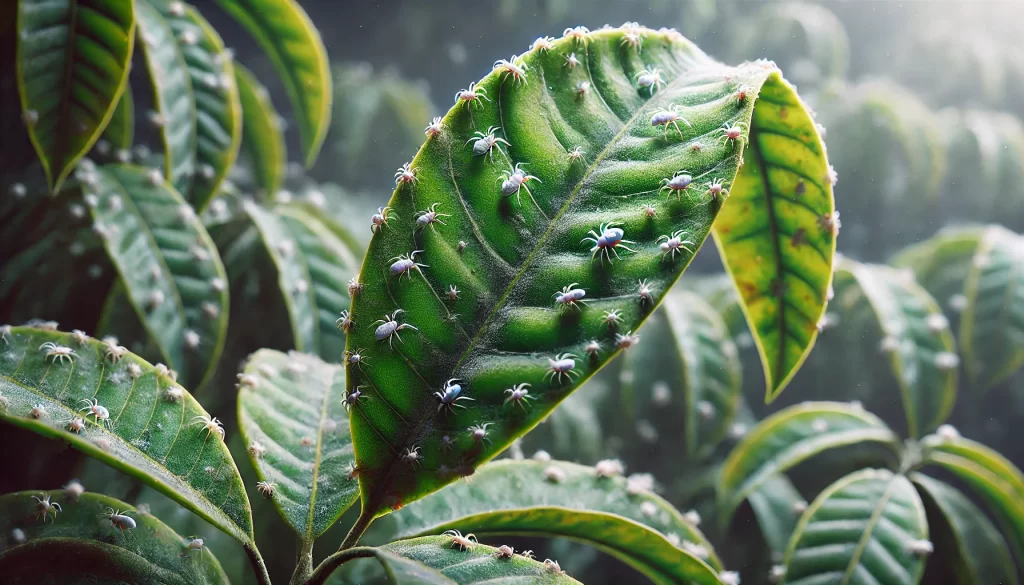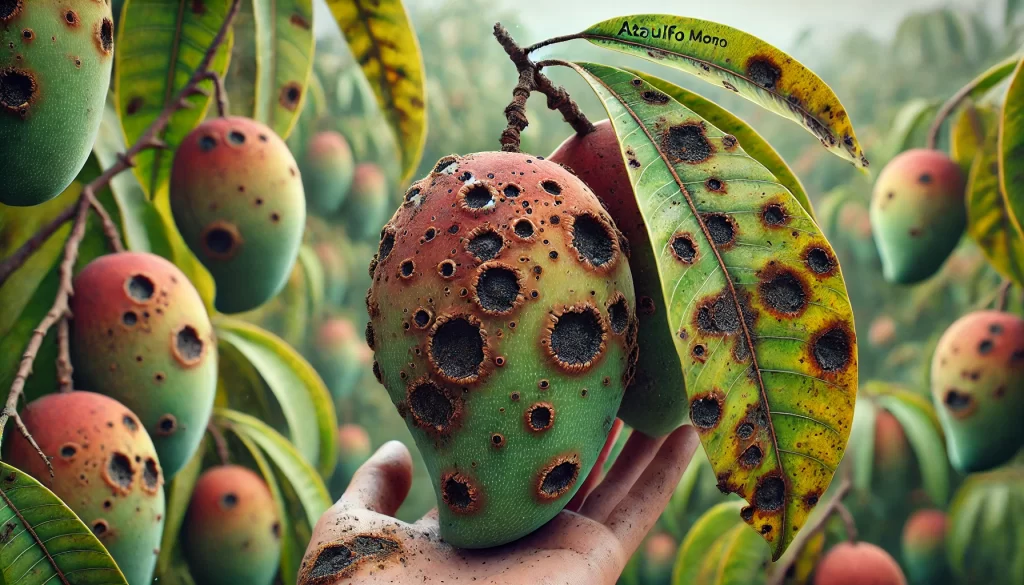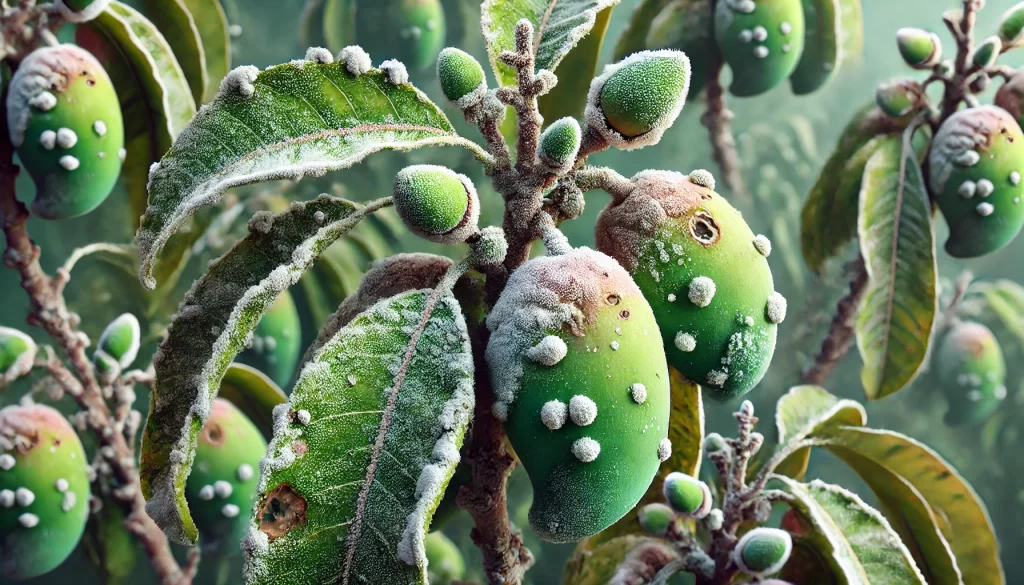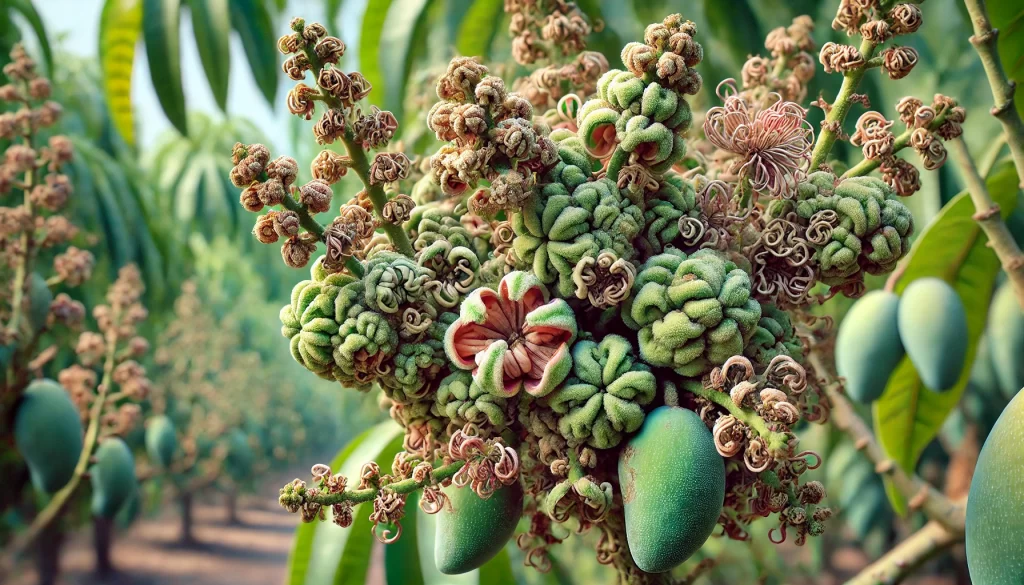Importance of Pest and Disease Control
Effective pest and disease control in Ataulfo mango cultivation is crucial to ensure high-quality production and minimize yield losses. Proper management involves preventive practices, constant monitoring, and the use of biological, cultural, and chemical controls when necessary. Below are the main pests and diseases affecting Ataulfo mango and the strategies for their control.

Main Pests of Ataulfo Mango
Fruit Fly (Anastrepha spp.)
Description
The fruit fly is one of the most devastating pests for mangoes, as the larvae develop inside the fruit, causing direct damage that reduces quality and commercial value.
Symptoms
- Presence of small holes in the skin of the fruit, caused by the fly’s oviposition.
- Internal damage to the fruit, with soft pulp and decay.
Control Strategies
- Monitoring: Use traps with attractants (such as hydrolyzed proteins or pheromones) to monitor fly populations.
- Cultural Control: Collect and destroy fallen fruits to eliminate sources of infestation.
- Biological Control: Release parasitoids such as Diachasmimorpha longicaudata, which attack the fly larvae.
- Chemical Control: Application of toxic baits and traps around the crop perimeter to reduce adult populations.
White Mite (Polyphagotarsonemus latus)
Description
The white mite is a pest that primarily affects leaves and young shoots, causing deformations that can reduce photosynthesis and tree growth.

Symptoms
- Curling and deformity of young leaves.
- Bronzing of affected shoots.
- Reduction in leaf and fruit size.
Control Strategies
- Monitoring: Regularly inspect leaves and young shoots for early infestations.
- Biological Control: Use natural predators such as Amblyseius swirskii or Phytoseiulus persimilis to control mite populations.
- Chemical Control: Apply specific acaricides when populations reach harmful levels, alternating products to avoid resistance.
Thrips (Thrips spp.)
Description
Thrips are tiny insects that feed on the sap of leaves, flowers, and young fruits, causing damage that can affect fruit quality.

Symptoms
- Silvery or brown spots on the leaf surface.
- Scarring on the fruit skin, affecting its appearance and commercial value.
- Premature drop of flowers and small fruits.
Control Strategies
- Monitoring: Use blue or yellow sticky traps to monitor thrips populations.
- Biological Control: Release predators such as Orius spp. or Neoseiulus cucumeris that feed on thrips.
- Chemical Control: Apply selective insecticides for thrips, ensuring not to affect natural enemies.
Main Diseases of Ataulfo Mango
Anthracnose (Colletotrichum gloeosporioides)
Description
Anthracnose is a fungal disease that affects various parts of the plant, including leaves, flowers, and fruits, and is especially destructive in humid climates.

Symptoms
- Black, sunken spots on leaves, flowers, and fruits.
- Premature drop of flowers and small fruits.
- Necrosis on leaf tips and shoots.
Control Strategies
- Cultural Management: Regular pruning to improve air circulation and reduce humidity in the tree canopy.
- Biological Control: Use biofungicides based on Trichoderma spp. to reduce anthracnose incidence.
- Chemical Control: Preventive application of copper or systemic fungicides before flowering and during fruit formation. It is crucial to apply fungicides in humid or rainy conditions.
Powdery Mildew (Erysiphe mangiferae)
Description
Powdery mildew is a fungus that affects leaves, flowers, and young fruits, covering them with a white powder that reduces photosynthesis and can lead to fruit drop.

Symptoms
- Presence of a white powdery layer on leaves, shoots, and fruits.
- Deformed and wrinkled leaves.
- Premature drop of flowers and small fruits.
Control Strategies
- Monitoring: Regular inspection of leaves and young shoots, especially during periods of high humidity.
- Cultural Control: Pruning of affected parts and improving ventilation in the tree canopy.
- Biological Control: Application of neem extracts or mineral oils to reduce disease severity.
- Chemical Control: Application of specific fungicides for powdery mildew, such as sulfur or systemic fungicides, in the early stages of the disease.
Floral Malformation (Fusarium spp.)
Description
Floral malformation is a disease that causes deformities in inflorescences, significantly reducing fruit production.

Symptoms
- Abnormally dense and compact inflorescences.
- Flowers with abnormal structures and no ability to produce fruits.
- Delayed flower opening.
Control Strategies
- Cultural Management: Remove and destroy affected inflorescences to prevent the spread of the disease.
- Biological Control: Research the use of microbial antagonists such as Trichoderma spp. to combat Fusarium.
- Chemical Control: Apply systemic fungicides during the inflorescence development stage.
Integrated Management Practices
1. Monitoring and Early Diagnosis
Constant orchard monitoring is key to detecting the presence of pests and diseases in time. It is important to train personnel to identify early symptoms and apply necessary control measures before they become a major problem.
2. Integrated Pest Management (IPM)
IPM combines cultural, biological, and chemical practices to manage pests and diseases sustainably. This includes rotating chemical products to avoid resistance, using biocontrol agents, and implementing cultural practices that reduce pest and pathogen habitats.
3. Responsible Use of Chemical Products
Chemicals should only be used when necessary and following technical recommendations to minimize environmental impact and protect the health of workers and consumers. It is essential to alternate products with different modes of action to avoid resistance development.
4. Sanitary Pruning and Canopy Management
Regular pruning to remove diseased branches, improve air circulation, and allow better sunlight penetration is essential to prevent disease proliferation. This also facilitates more effective application of phytosanitary treatments.
 AgronoBlog – Agriculture Blog
AgronoBlog – Agriculture Blog 
